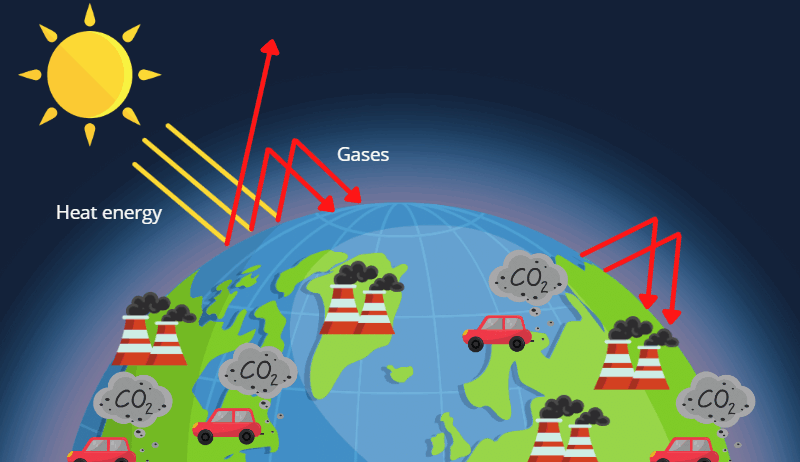The greenhouse effect, a natural phenomenon, is instrumental in maintaining Earth’s temperature. However, the intensification of this effect due to human activities has led to alarming repercussions. What if Earth were a greenhouse, and we were the gardeners tampering with its carefully balanced environment? As we explore the complexities of this issue, we’re faced with a formidable challenge: how do we effectively mitigate the consequences of our actions while fostering a sustainable relationship with our planet?
To grasp the greenhouse effect, we must first comprehend the roles of greenhouse gases. These gases—chiefly carbon dioxide (CO2), methane (CH4), nitrous oxide (N2O), and water vapor—allow sunlight to enter the atmosphere but trap heat as it tries to escape back into space. This process results in a warming effect that has historically been beneficial, enabling life to thrive on our planet. Yet, since the Industrial Revolution, human activities, particularly the combustion of fossil fuels and deforestation, have significantly increased the concentration of these gases.
When we burn fossil fuels—coal, oil, and natural gas—we release vast amounts of CO2 into the atmosphere. This excess CO2 interacts with solar radiation, amplifying the greenhouse effect. The consequences? A notable rise in average global temperatures, alterations in weather patterns, and ecological disturbances that threaten biodiversity.
Consider this: the Intergovernmental Panel on Climate Change (IPCC) states that the planet’s temperature has already increased by approximately 1.1 degrees Celsius since the late 19th century. This rise may seem trivial, yet it is far from benign. Even slight increases in temperature can precipitate catastrophic environmental changes. Ecosystems, which rely on specific temperature ranges, may falter under rising conditions. For instance, coral reefs, which are highly sensitive to temperature fluctuations, may experience bleaching and subsequent die-off, resulting in the loss of marine biodiversity.
The implications extend beyond environmental degradation. Increased temperatures contribute to the proliferation of extreme weather events. From devastating hurricanes to scorching heatwaves, the manifestations are increasingly apparent. Could we endure a future where weather becomes erratic, and communities must grapple with the aftermath of unrelenting natural disasters? The challenge lies not merely in adaptation but also in reversing this trend. Climate resilience must be coupled with proactive measures to curb emissions and rehabilitate damaged ecosystems.
Another significant participant in the greenhouse effect is methane. Emitted during the production and transportation of coal, oil, and natural gas, as well as from livestock and other agricultural practices, methane is over twenty times more potent than CO2 over a century. Its short atmospheric lifespan—about a decade—means swift action can alleviate its impact. Perhaps a playful challenge poses itself: what if we could harness this potent gas for good, utilizing it as a renewable energy source while simultaneously curtailing its release into the atmosphere?
A potential solution lies in regenerative agricultural practices. By implementing techniques such as cover cropping, reduced tillage, and rotational grazing, we can enhance carbon sequestration in soils. This approach not only mitigates greenhouse gas emissions but also builds soil health and enhances food security. Farmers could become frontline warriors in the battle against climate change, transforming traditional practices into powerful tools for carbon management.
Moving from the agricultural landscape to urban centers, the influence of urbanization on the greenhouse effect cannot be overlooked. Cities are responsible for approximately 70% of global greenhouse gas emissions. As urban areas expand, the infamous urban heat island effect exacerbates local temperatures, further fueling the cycle of heating. Integrating green architecture, investing in public transportation, and promoting energy-efficient technologies are pivotal steps towards sustainable urban development. How might our cities look if we redesigned them with climate resilience at their core?
Adapting to climate change also calls for a transformation in energy production. The transition from fossil fuels to renewable energy sources—solar, wind, hydro, and geothermal—is imperative. Governments and corporations are increasingly pledging to reduce their carbon footprint, driven by public demand for sustainable practices. This transition requires innovation—can we develop technology that captures and repurposes atmospheric CO2? Carbon capture and storage (CCS) technologies, while still in nascent stages, hold promise as viable alternatives.
The cooperative nature of the climate crisis is another consideration. Climate change knows no borders, and its effects are globally interconnected. The pursuit of solutions must involve collaboration between nations, sharing technology, knowledge, and resources to combat this issue collectively. Are we ready to transcend geographic and political boundaries for the sake of our planet?
In summary, the greenhouse effect is an intricate mechanism that keeps our planet habitable; however, human intervention has thrown it into disarray. The challenge is clear: we must curtail greenhouse gas emissions and adapt our practices sustainably to mitigate the impending consequences of climate change. The question posited earlier still lingers—how can we reshape our world to ensure a resilient future? By harnessing innovation, embracing sustainable practices, and fostering global cooperation, we can shift the trajectory towards a healthier planet for generations to come. As stewards of the Earth, it is our responsibility to secure a thriving ecosystem, for we are, undoubtedly, inextricably linked to the fate of our environment.







